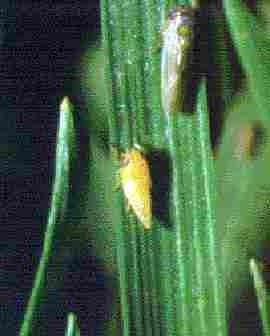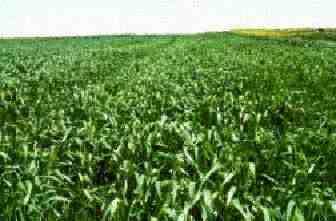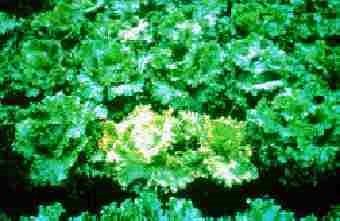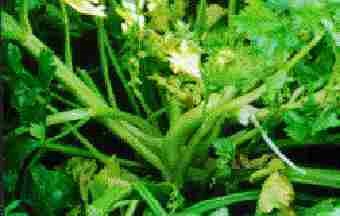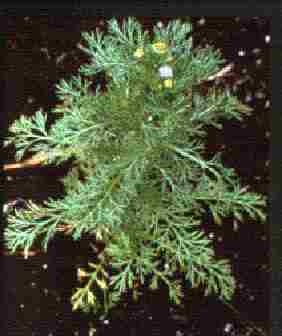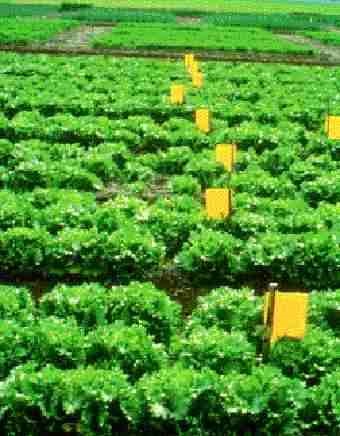Aster leafhopper and aster yellows
Learn about the biology, damage, hosts and management of aster leafhopper and aster yellows.
ISSN 1198-712X, Published August 1998
Introduction
Aster yellows disease causes periodic and occasionally extensive damage to lettuce, celery and carrot crops grown in Ontario. Aster yellows is caused by a mycoplasma-like organism and is disseminated by the aster leafhopper, Macrosteles phytoplasma (AYP).
The aster leafhopper completes 3–5 generations in southern Ontario after overwintering in the egg stage. In some years, populations originating in the southern USA may spread into Ontario and contribute to leafhopper infestations. Some of these migrants may be infected with AYP. Both the leafhopper and the AYP have a large number of plant hosts, a fact which contributes greatly to annual fluctuations in the incidence of aster yellows in crops.
Biology of the leafhopper
In Ontario, the aster leafhopper overwinters as an egg in the leaf tissue of winter grains such as wheat and rye (Figure 2). Snowcover promotes survival of leafhopper eggs. Adult leafhoppers cannot survive winters in southern Ontario. Once enough degree days for development have accumulated in the spring, the eggs will hatch into nymphs. Approximately 130 degree days above 9°C are required for egg maturation based on temperatures at grass levels and an additional 270 degree days are required for development to adulthood. As the winter grains mature in late May and early June, local first-generation leafhoppers disperse to more favourable hosts such as weeds, grasses, and vegetable crops. During the growing season significant populations may be produced on spring grains.
Migrant leafhoppers from the USA may arrive following persistent southerly flow of warm air with rainshowers associated with cold fronts. As grain matures from south to north in the USA, a corresponding movement of adult leafhoppers into Ontario may take place. Because leafhopper movements are regulated by wind and weather patterns, migrations into Ontario are not consistent from year to year. Both local dispersal and long distance migration influences the incidence and severity of the aster leafhopper infestations and aster yellows.
Damage from aster yellows
Aster leafhoppers that carry AYP feed on susceptible crops by inserting their mouthparts into the phloem tissue. The AYP cannot be immediately transmitted by a leafhopper because the AYP must multiply inside the insect. This time period is called the incubation period and takes 2–3 weeks and the insect is infected for life.
Infected leafhoppers must feed on a susceptible plant for a sufficient time to inoculate it with the AYP and the pathogen must multiply in the plant before symptoms appear. For young lettuce or celery plants, aster yellows symptoms may appear in 7 days while in older plants symptoms occur after 14–21 days (Figure 3 and Figure 4). Disease severity in a crop is related to the size of the leafhopper populations, the percent of the population that is infectious and the ability of those individuals to transmit the pathogen. Large numbers of leafhoppers does not necessarily result in more severe infection of aster yellows. In some years the percent infectivity of the insects has been less than 2% and the subsequent aster yellows levels in vegetable crops has remained below 1%. If the percent infectivity were higher, possibly more aster yellows would result. In addition, other factors such as temperature and moisture greatly influence the severity of aster yellows. Hot, dry summers reduce the numbers of aster leafhoppers and the amount of yellows infection and drought conditions reduce the sources of suitable host plants of the leafhopper. However, low infestations of leafhoppers with a high proportion of infected individuals (greater than 2%) could cause serious outbreaks of aster yellows.
Wild hosts
Both the aster leafhoppers and AYP have a wide range of host plants which include many broadleafs weeds, grains and grasses. Weeds that occur near crops may influence the densities of leafhoppers in the crop, by their effect on the survival of the insect and its natural enemies. In addition, certain weeds in cultivated crops may influence the incidence of the disease.
Over 300 species of plants have been identified as hosts of AYP . This includes grains such as wheat, oats, rye and barley as well as many common Ontario weeds such as quackgrass, plantain, chickory, knotweed, lambs-quarters, wild asters, sowthistle, ragweed, stinkweed, and wild carrot. Pineappleweed and Kentucky bluegrass are favoured hosts in the Holland Marsh region (Figure 5 and Figure 6).
Management
Serious outbreaks of aster yellows in the Holland Bradford-Marsh have resulted in 15–50% losses of lettuce. The proportion or percentage of leafhoppers carrying the disease cannot be easily determined, however technology is available to test leafhoppers for their infectivity level. Unfortunately this technology is not commercially available yet in Ontario.
The three parameters, leafhopper infectivity, leafhopper abundance and percent yellows infection, are the key elements of the epidemiology of aster yellows. Currently, only leafhopper abundance data and percent yellows infection can be collected economically. In years when leafhopper populations are high, the presence of alternate wild hosts helps to sustain and prolong the leafhopper population by providing feeding and breeding sites during periods of dispersal or when preferred crops are unavailable. When infectivity of leafhoppers is high, more wild hosts will be exposed to aster yellows and subsequently act as disease sources. Infected perennial weeds would act as reservoirs of aster yellows and would influence the level of disease in the next season.
Two methods can be used to monitor leafhoppers. Yellow or orange sticky traps can be used to monitor aster leafhoppers in lettuce, celery and carrots, however they must be checked daily so that rapid changes in the population can be detected (Figure 7). Timing is critical for this pest. The sticky trap method is effective at detecting major increases in the leafhopper population in a region.
Nylon/cloth sweep nets can be used to monitor leafhoppers in individual fields. The aster leafhopper will fly in short bursts between plants depending on wind conditions. Sweep nets work best when wind speeds are low and the foliage is dry. For carrots, celery and lettuce record the number of aster leafhoppers per 100 sweeps. One sweep equals one pass over the foliage and it is recommended to do 20 sweeps in 5 locations per field.
The treatment threshold varies not only between lettuce, celery and carrots but also from year to year, depending on the forecasted potential for aster yellows. The infectivity of the leafhoppers can be determined early in the season by tracking US populations and testing local leafhoppers. The infectivity combined with the numbers caught in the sweep net determines the annual potential for disease.
An aster yellows index (AYI) determines the need to treat a crop. The AYI is calculated by multiplying the infectivity level by the average number of leafhoppers collected per 100 sweeps (Infectivity Rate) x (100 Sweeps) = (Aster Yellows Index).
In Ontario, many of the carrot varieties have not been evaluated for aster yellows tolerance. Spartan Bonus is considered susceptible whereas Six Pak II is considered resistant. Growers should use an AYI of 70 as a guideline for other varieties.
| Crop | Aster Yellows Index |
|---|---|
| Carrots — resistant | 100 |
| Carrots — intermediate | 70 |
| Carrots — susceptible | 50 |
| Celery, romaine | 30–35 |
| Head lettuce | 20–25 |
